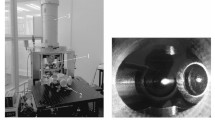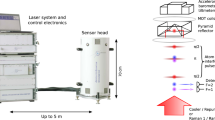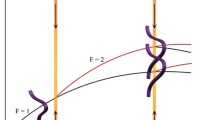With the development of laser fountain cooling and technologies for the control of the motion of atoms in Russia it has become possible to create atomic interferometric gravimeters with accuracy characteristics comparable to those of free-fall corner-reflector gravimeters. The short-term stability of the atomic gravimeters exceeds that of existing gravimeters.
Similar content being viewed by others
Avoid common mistakes on your manuscript.
Over the last 20 years the development of atomic interferometry of matter waves has led to improvements in the inertial-force measuring techniques [1] employed in basic research and applications. Atomic interferometry has been used in new inertial sensors which can now compete with the most precise classical instruments of this type. The number of applications of atomic interference inertial sensors is increasing rapidly, from measurements of the fundamental constants of physics, such as the gravitational constant G [2] and rotation parameters, to the development of portable compact instruments, gravimeters, and gradiometers. These instruments are used in navigation and in cartography of gravitational fields, including under low gravitation conditions [3].
Measurements of the acceleration g of gravity on the earth's surface provide important geophysical information about the earth's interior structure, the localization of underground density changes, and changes in the gravitational field with time owing to various deformation processes. Gravimeters for resolving spatial gravitational variations require a sensitivity on the order of 20 μGal (1 Gal = 10−2 m/sec2 = 10−3g). The rate of local changes in g for many deformation processes is 1 μGal/yr. Absolute measurements of g are of great importance, for example, in the creation of a new standard of mass [4].
The principles of atomic interferometry based on a two-photon Raman process have been described in detail elsewhere [5]. In this process, long-lived levels |a〉 and |b〉 of the ground state of an atom are coupled by two light fields through a common intermediate level |e〉 which lies far (several gigahertz) from the nearest excited level that is coupled to levels |a〉 and |b〉 by a single-photon absorption process. An atom can be either in state |a〉 (dark lines) or |b〉 (grey lines) (Fig. 1). The operating principle of the atomic interferometer can be explained in terms of three Raman pulses separated in time and (or) space. The first π/2-pulse shifts atoms that were initially in one of the ground state levels into a coherent superposition of states |a〉 and |b〉. In the standing wave created by counter propagating light, this pulse, like a split beam in optics, creates two spatially separated material waves. A subsequent π-pulse inverts both of the internal states and the momenta of both material waves like a mirror. A third π/2-pulse leads to spatial recombination and mixing of the material waves in a way analogous to the effect of the first π/2-pulse.
The change in the phase difference between the material waves leads to a change in the difference of the populations between atomic states |a〉 and |b〉. This difference is measured using a state-selective fluorescence detection process that is exactly the same as using in fountain-type atomic frequency standards for measuring the probability of a microwave clock transition:
where N |a〉 and N |b〉 are the numbers of atoms in states |a〉 and |b〉, respectively.
In an atomic interferometer, the transition probability
depends on the relative phases ∆φi and ∆φp, respectively, of the two material waves in the interferometer and of the light waves between the first and second, and second and third Raman pulses:
where C is the contrast of the detected signal of the interferometer and ∆φp = φ1 – 2φ2 + φ3 is the generalized phase, which is the result of the interaction of the atomic dipole with the ith Raman pulse (i = 1, 2, 3).
The phase difference of the interferometer ∆φi depends only on the relative motion of an atom relative to the light fields controlling the Raman pulses. This motion is caused by inertial forces resulting from rotation and free fall, so that ∆φi = ∆φrot + ∆φ g .
The phase shift owing to rotation,
depends on the area S upon which the material waves of the interferometer are incident normal to the area, the rotation vector w, the relativistic energy E = mc 2 of the atom of mass m, the speed c of light and the Planck constant. It has been shown [6], for example, that for a rubidium atom and visible light of frequency ν in an atomic interferometer, this phase shift is a factor mc 2/n ~ 1010 greater than in optical interferometers for the same covered areas. This demonstrates the great potential of atomic interferometers as alternatives to gyroscopes based exclusively on light waves, despite a lower signal-to-noise ratio and area covered by the interferometer.
The acceleration g of gravity produces a phase shift in the interferometer of
where k eff is the effective wave vector of the Raman laser beams, and T is the time between pulses. Thus, by choosing a suitable interferometer geometry it is possible to operate it so that it runs only as a gravimeter or gyroscope; this confirms the broad functional capabilities of atomic interferometry. In the vertical standing wave formed by the Raman light, the interferometer will be a gravimeter. In atomic gravimeters, as in fountain-type frequency standards, vertical motion of the atoms occurs as the result of the ejection of a cloud of atoms cooled by the laser light to temperatures on the order of 1 μK. Low velocities (of order 1 cm/sec) of the atoms make it possible to increase the interval T and, thereby, the sensitivity of the gravimeter.
The characteristics of existing gravimeters have been compared in Ref. 5. An analysis of their noise characteristics shows that the classical gravimeter based on free fall of a corner reflector and atomic gravimeters are independent of signal drift and do not require periodic recalibration. Recalibration is not needed because in both cases the frequency of laser light with a known frequency associated with optical transition frequencies (that do not drift over time) is used to calculate the acceleration of gravity.
Thus, today only two absolute gravimeters are capable of providing the required measurement accuracy in measuring the acceleration of gravity at a level of 10−9g or 1 μGal. These are the atomic gravimeter, developed in the laboratory of Nobel laureate Stephen Chu [5], and the FG5 industrial corner-cube free-fall gravimeter from Micro-g Solutions [7, 8]. The latter is a laser interferometer formed by two corner reflectors, one of which is periodically in free fall while the other is fixed (Fig. 2). The number of interference peaks corresponding to the free fall length L over the free-fall time T is determined; the acceleration of gravity is given by g = 2L/T 2, the measurement cycle frequency is 0.1 Hz, and the duration of a single measurement is 200 msec. The transient resolution or sensitivity is 4–15 μGal in a 15 minute measurement, and the long-time resolution is 1 μGal over 10 h. The unexcluded systematic measurement error is 2 μGal. The low repetition rate of the measurement cycles increases the sensitivity of the corner-reflector gravimeter to low frequency noise.
In the atomic interferometer [5] the detected signal is proportional to the change in position of the atoms over the time between the Raman pulses at 0 and T, T and 2T. The difference in the position is proportional to the acceleration g. The measurement cycle frequency is 2–3 Hz and the duration of a single measurement is 200 msec. The transient resolution is 3 μGal over 1 minute of measurements and the long-time resolution of 0.1 μGal over 48 h. Attaining such a long averaging time, determined by uninterrupted operation of the laser system of the interferometer, is not currently a great problem. For example, the laser system in a fountain-type cesium frequency standard operating at VNIIFTRI [9] is capable of running without disruption of automatic frequency tuning for several weeks. The unexcluded systematic error for the gravimeter measurements is 3 μGal. The high measurement cycle frequency means that averaging can be carried out over shorter time intervals.
Until recently, atomic gravimeters were structurally and functionally more complicated and cumbersome than the classical systems, in particular those with corner reflectors. However, as atom cooling techniques have developed and new highly stable laser systems appeared, the design of atomic gravimeters has become simpler.
The use of atomic cooling techniques in compact magneto-optical traps (MOT) (Fig. 3), along with the use of highly stable fiberoptic laser and optoelectronic systems in gravimeters, has made it possible [3, 10, 11] to produce compact atomic gravimeters with volumes of a few liters compared to the hundreds of liters for fountain-type gravimeters. Similar instruments equipped with systems for compensating residual vibrational noise by means of correction signals from an auxiliary mechanical seismometer have opened up new prospects for local or spacecraft-mounted gravimetry. Despite the shorter sampling cycle of gravimeters with free fall of slow atoms incident from MOT compared to fountain-type gravimeters, the former still have excellent transient stability for measuring g at levels of a few times 10−8 g over averaging times of 1 sec. This is primarily because a high stability laser system with low phase noise is used, along with efficient detection circuits for detecting the atomic phase and suppressing vibrational noise. The noise in measurements of the transition probability determined from the difference in the populations of hyperfine levels of the ground state of alkali atoms is limited by quantum projection noise σ ~ N –1/2, where σ is the standard deviation in the measured transition probability P |a〉 (Eq. (1)) and N = N |a〉 + N |b〉 is the total number of detected atoms [12]. When a large number of atoms are detected, as with the use of an MOT and auxiliary slow atom sources, this noise comes to dominate the other sources such as shot noise of the photodetectors, which is also proportional to N –1/2, the noise of the detection system, which is proportional to N −1, and the phase noise of the frequency difference in the Raman laser light.
Therefore, the development of atomic gravimeters based on cold atoms with accuracies comparable to those of classical gravimeters is a soluble and realistic problem. Laser atom cooling techniques developed at VNIIFTRI for making fountain-type microwave frequency standards, as well as new design approaches for compact atomic interferometers with an extended range of functional capabilities, can be used to build atomic interference gravimeters.
References
P. R. Berman (ed.), Atom Interferometry, Academic Press, San Diego (1997).
F. Sorrentino et al., “Sensitive gravity-gradiometry with atom interferometry: progress towards an improved determination of gravitational constant,” New J. Phys., 12, 095009–096009 (2010).
G. Stern et al., “Light-pulse atom interferometry in microgravity,” Eur. Phys. J. D, 53, 353–357 (2009).
I. Robinson and B. Kibble, “An initial measurement of Planck's constant using the NPL Mark II watt balance,” Metrologia, 44, 427–440 (2007).
A. Peters, K. Chung, and S. Cho, “High-precision gravity measurement using atom interferometry,” Metrologia, 38, 25–61 (2001).
T. Muller et al., “A compact dual atom interferometer gyroscope based on laser-cooled rubidium,” Eur. Phys. J. D, 53, 273–281 (2009).
J. Hinderer et al., “Tides, earthquakes, and ground noise as seen by the absolute gravimeter FG5 and its superspring; comparison with a superconducting gravimeter and a broadband seismometer,” Metrologia, 39, 495–501 (2002).
L. Vitushkin et al., “Results of the Sixth International Comparison of Absolute Gravimeters, ICAG-2001,” Metrologia, 39, 407–424 (2002).
Yu. I. Domnin et al., “The MTsR-F2 fountain-type cesium frequency standard,” Izmer. Tekhn., No. 10, 26–30 (2012); Measur. Techn., 55, No. 10, 1155–1162 (2012).
Q. Bodart et al., “Cold atom pyramidal gravimeter with a single laser beam,” Appl. Phys. Lett., 96, 134101 (2010).
J. Le Gouet et al., “Limits to the sensitivity of a low noise compact atomic gravimeter,” Appl. Phys. B, 92, 133–144 (2008).
G. Santarelli et al., “Quantum projection noise in an atomic fountain: A high stability cesium frequency standard,” Phys. Rev. Lett., 82, 4619–4622 (1999).
Author information
Authors and Affiliations
Corresponding author
Additional information
Translated from Izmeritel'naya Tekhnika, No. 12, pp. 3–6, December, 2014.
Rights and permissions
About this article
Cite this article
Baryshev, V.N., Blinov, I.Y. Application of Atomic Interferometers in Gravimetry. Meas Tech 57, 1333–1337 (2015). https://doi.org/10.1007/s11018-015-0630-5
Received:
Published:
Issue Date:
DOI: https://doi.org/10.1007/s11018-015-0630-5







